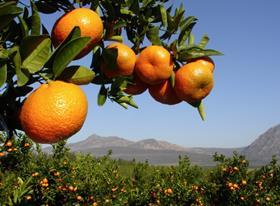
The past year has been an uneven one for the citrus category, with value sales only marginally increasing on the back of price rises while volumes have dropped by 2.2 per cent.
Lemons continue to be a star performer, driving the category with 8.2 per cent volume growth as the popularity of ‘ingredients’ and home mixology show no sign of abating, but there have also been other pockets of success.
According to Paul Wise, a fruit salesman from Gilgrove at New Covent Garden Market, there has been stronger demand for Queen-brand satsumas from Spain – a late-season natural hybrid of mandarin and Satsuma – than ever before. “We’ve had different box counts but the 72s were most popular,” he explains. “Clementine mandarins and satsumas finish up beginning of January but what’s special about Queen satsumas is that they’re available from January right through until the end of April. I suspect the good quantity of supply this year is down to a good crop.”
And less-mainstream products have also been doing a strong trade on the market, according to James Dew, managing director of Harwoods of Kent. “Pomelo has definitely been more fashionable on menus this year, especially Asian-inspired restaurants,” he reports. “It’s got a milder, less sharp flavour than some citrus and doesn’t overwhelm other ingredients in a dish. Plus pomelo was good value this year which also makes it popular with chefs.”
Spanish kumquats also had very good taste and sold very well, according to Dew, with bars liking them. Moro blood oranges continue to be popular.
From a supply perspective, there have been a number of complications though. The season isn’t being helped by shortages caused by South Africa’s water crisis (see page 16), and although the most recent update suggests overall export volumes from Southern Africa will rise, the situation is less than ideal.
In Florida, orange and grapefruit production is expected to remain steady, according to a new forecast by the United States Department of Agriculture, but that still remains lower than in previous years. The USDA’s March report estimates Florida orange production for 2017-18 to remain at 45m boxes, a 35 per cent decrease over last season and the lowest crop size in more than 75 years.
Florida grapefruit production remained at 4.65m boxes, a decrease of 40 per cent over last season, while there was a small increase in Florida speciality fruit, which includes tangerines and tangelos.
“With the recent passing of federal disaster recovery relief and a fresh bloom on the trees, Florida’s growers can again focus on what matters most: growing the best-tasting oranges and grapefruit in the world,” says Shannon Shepp, executive director of the Florida Department of Citrus.
Hurricane Irma had a devastating impact on the Florida Citrus industry, with growers reporting 30 to 70 per cent crop loss after its landfall on 10 September, with the southwest region of the state receiving the most damage.
The hurricane uprooted trees and left many groves sitting in standing water for up to three weeks, potentially damaging the root systems and impacting future seasons’ growth.
In October, the Florida Department of Agriculture and Consumer Services announced that Florida Citrus sustained more than $760m in damages due to Hurricane Irma.
Prior to Hurricane Irma, Florida was expected to produce about 75m boxes of oranges this season, according to private estimates.



